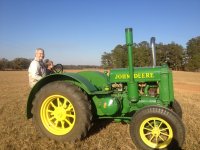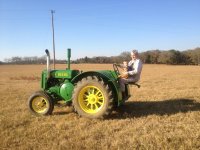Farmerford
Platinum Member
- Joined
- Dec 9, 2006
- Messages
- 733
- Location
- Columbus, Georgia
- Tractor
- Kuborta B2400, L2900, L4330; Caterpillar D3B, John Deere 455D
I have lately noticed several members sharing their old tractors. I thought you might be interested in my family's 1936 John Deere D. In the attached pictures my grandson and I are playing with it on the family farm in southwest Georgia at Thanksgiving. We were looking for one to restore, but this one was so well done and at a reasonable price that we bought it.
The D is the largest two cylinder John Deere made: 501 cubic inches. And also the longest lived: first one in 1925 (?) and last one in 1953. This one has apparently been bored out 0.125 and is several cubic inches larger. Despite the cubic inches, it only makes 45 horsepower at maximum 900 rpm because the compression is about 5.0:1; it was designed to run on distillate, which produces less power than gasoline. Distillate is a kerosene like fuel that was cheaper than gasoline in the 20's and 30's; I think because there was little demand for the diesel fuel that could have been made instead of the distillate. The D has a small one gallon tank for gasoline that is switched in to start it and when it is shut down (so the carburetor will be full of gasoline for starting the next day). At 5 gallons per hour it would not be economical on today's farm.
It has no electrics; you start it by opening the compression releases on the cylinders and turning the flywheel on the left side. It has an impulse magneto, which makes a hot spark at even very slow speeds; so you don't have to spin the flywheel fast, just pull it past TDC when the impulse coupling on the magneto trips and gives you a hot spark. IF everything is tuned just right, and if you have not flooded it.
It has a three speed transmission and hand clutch. Maximum speed is about 5 mph in top gear. No brakes on the rear wheels; when it is in gear there is a fairly effective brake built into the clutch. But if it is not in gear, that brake does not work; you are left with only the marginal "parking brake" that was used to hold it still when it was used to power machinery (like a threshing machine) via a flat belt on the right side clutch pulley.
The only additional work is to install a dual exhaust manifold (they are actually available aftermarket) and a second chrome stack; hope the old girl is not embarrassed.
The D is the largest two cylinder John Deere made: 501 cubic inches. And also the longest lived: first one in 1925 (?) and last one in 1953. This one has apparently been bored out 0.125 and is several cubic inches larger. Despite the cubic inches, it only makes 45 horsepower at maximum 900 rpm because the compression is about 5.0:1; it was designed to run on distillate, which produces less power than gasoline. Distillate is a kerosene like fuel that was cheaper than gasoline in the 20's and 30's; I think because there was little demand for the diesel fuel that could have been made instead of the distillate. The D has a small one gallon tank for gasoline that is switched in to start it and when it is shut down (so the carburetor will be full of gasoline for starting the next day). At 5 gallons per hour it would not be economical on today's farm.
It has no electrics; you start it by opening the compression releases on the cylinders and turning the flywheel on the left side. It has an impulse magneto, which makes a hot spark at even very slow speeds; so you don't have to spin the flywheel fast, just pull it past TDC when the impulse coupling on the magneto trips and gives you a hot spark. IF everything is tuned just right, and if you have not flooded it.
It has a three speed transmission and hand clutch. Maximum speed is about 5 mph in top gear. No brakes on the rear wheels; when it is in gear there is a fairly effective brake built into the clutch. But if it is not in gear, that brake does not work; you are left with only the marginal "parking brake" that was used to hold it still when it was used to power machinery (like a threshing machine) via a flat belt on the right side clutch pulley.
The only additional work is to install a dual exhaust manifold (they are actually available aftermarket) and a second chrome stack; hope the old girl is not embarrassed.

